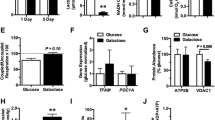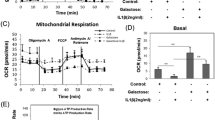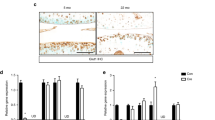Abstract
The adequate provision of glucose to articular chondrocytes is essential to sustain their predominantly anaerobic metabolism; glucose is also a precursor for the extracellular matrix macromolecules which these cells synthesise. Impaired glucose uptake would compromise cell function and potentially result in an imbalance of matrix synthesis and degradation, leading to osteoarthritis. We studied the glucose influx pathway into bovine articular chondrocytes using 2-deoxy-d-[3H]-glucose (DOG). Uptake occurs via an extracellular pH (pHo)-insensitive, phloretin- and cytochalasin B-sensitive pathway, hallmarks of the GLUT family of facilitative glucose transporters, with a K m of 0.35±0.11 mM. Uptake was affected by a number of physiologically relevant factors: (1) raised hydrostatic pressure (1–30 MPa) inhibited DOG uptake by up to 30%; (2) interleukin-1 (IL-1β) reduced uptake via an increase in transporter affinity; (3) glucosamine inhibited glucose uptake in a manner consistent with the actions of a competitive inhibitor. Given the involvement of IL-1β in osteoarthritis and the protective role assigned to glucosamine, these findings implicate an important role for glucose delivery in chondrocyte energy production and matrix metabolism, which, therefore, may potentially affect the maintenance of cartilage integrity.






Similar content being viewed by others
References
Arbuckle MI, Kane S, Porter LM, Seatter MJ, Gould GW (1996) Structure-function analysis of liver-type (GLUT2) and brain-type (GLUT3) glucose transporters: expression of chimeric transporters in Xenopus oocytes suggests an important role for putative transmembrane helix 7 in determining substrate selectivity. Biochemistry 35:16519–16527
Browning JA, Walker RE, Hall AC, Wilkins RJ (1999) Modulation of Na+×H+ exchange by hydrostatic pressure in isolated bovine articular chondrocytes. Acta Physiol Scand 166:39–45
Fenton JI, Chlebek-Brown KA, Peters TL, Caron JP, Orth MW (2000) Glucosamine HCl reduces equine articular cartilage degradation in explant culture. Osteoarthritis Cartilage 8:258–265
Gouze JN, Bordji K, Gulberti S, Terlain B, Netter P, Magdalou J, Fournel-Gigleux S, Ouzzine M (2001) Interleukin-1beta down-regulates the expression of glucuronosyltransferase I, a key enzyme priming glycosaminoglycan biosynthesis: influence of glucosamine on interleukin-1beta-mediated effects in rat chondrocytes. Arthritis Rheum 4:351–360
Gouze JN, Bianchi A, Becuwe P, Dauca M, Netter P, Magdalou J, Terlain B, Bordji K (2002) Glucosamine modulates IL-1-induced activation of rat chondrocytes at a receptor level, and by inhibiting the NF-kappa B pathway. FEBS Lett 510:166–170
Hernvann A, Jaffray P, Hilliquin P, Cazalet C, Menkes CJ, Ekindjian OG (1996) Interleukin-1 beta-mediated glucose uptake by chondrocytes. Inhibition by cortisol. Osteoarthritis Cartilage 4:139–142
Hodge WA, Fijan RS, Carlson KL, Burgess RL, Harris WH, Mann RW (1986) Contact pressures in the human hip joint measured in vivo. Proc Natl Acad Sci USA 83:2879–2883
Kasahara TKM (1997) Characterisation of rat Glut4 glucose transporter expressed in the yeast Saccharomyces cerevisiae: comparison with Glut1 glucose transporter. Biochim Biophys Acta 21:111–119
Loyau G, Pujol JP (1990) The role of cytokines in the development of osteoarthritis. Scand J Rheumatol Suppl 81:8–12
McAlindon T (2001) Glucosamine and chondroitin for osteoarthritis? Bull Rheum Dis 50:1–4
Meredith D, Bell P, McClure B, Wilkins RJ (2002) Functional and molecular characterization of lactic acid transport in bovine articular chondrocytes. Cell Physiol Biochem 12:227–234
Mobasheri A, Neama G, Bell S, Richardson S, Carter SD (2002) Human articular chondrocytes express three facilitative glucose transporter isoforms: GLUT1, GLUT3 and GLUT9. Cell Biol Int 26:297–300
Naftalin RJ, Afzal I, Browning JA, Wilkins RJ, Ellory JC. (2002) Effects of high pressure on glucose transport in the human erythrocyte. J Membr Biol 186:113–129
Piperno M, Reboul P, Hellio Le Graverand MP, Peschard MJ, Annefeld M, Richard M, Vignon E (2000) Glucosamine sulfate modulates dysregulated activities of human osteoarthritic chondrocytes in vitro. Osteoarthritis Cartilage 8:207–212
Reinster JY, Deroisy R, Rovati LC, Lee RL, Lejune E, Bruyere O, Giacovelli G, Henrotin Y, Dacre JE, Gossett C (2001) Long-term effects of glucosamine sulphate on osteoarthritis progression: a randomised, placebo-controlled clinical trial. Lancet 357:251–256
Richardson, S, Neama, G, Phillips, T, Bell, S, Carter, SD, Moley, KH, Moley, JF, Vannucci, SJ, Mobasheri, A (2003) Molecular characterisation and partial cDNA cloning of facilitative glucose transporters expressed in human articular chondrocytes: stimulation of 2-deoxyglucose uptake by IGF-1 and elevated MMP-2 secretion by glucose deprivation. Osteoarthritis Cartilage 11:92–101
Sandy JD, Gamett D, Thompson V, Verscharen C (1998) Chondrocyte-mediated catabolism of aggrecan: aggrecanase-dependent cleavage induced by interleukin-1 or retinoic acid can be inhibited by glucosamine. Biochem J 335:59–66
Shikhman AR, Brinson DC, Valbracht J, Lotz MK (2001) Cytokine regulation of facilitated glucose transport in human articular chondrocytes. J Immunol 167:7001–7008
Thorne SD, Hall AC, Lowe AG (1992) Effects of pressure on glucose transport in human erythrocytes. FEBS Lett 301:299–302
Uldry M, Ibberson M, Hosokawa M, Thorens B (2002) GLUT2 is a high affinity glucosamine transporter. FEBS Lett 524:199–203
Urban JPG, Lee RB (1997) Evidence for a negative Pasteur effect in articular cartilage. Biochem J 321:95–102
Widdas WF, Baker GF (1998) The physiological properties of human red cells as derived from kinetic osmotic volume changes. Cytobios 95:173–201
Wilkins RJ, Hall AC (1995) Control of matrix synthesis in isolated bovine chondrocytes by extracellular and intracellular pH. J Cell Physiol 164:474–481
Wilkins RJ, Browning JA, Ellory JC (2000) Surviving in a matrix: membrane transport in articular chondrocytes. J Membr Biol 177:95–108
Wilkins RJ, Windhaber RAJ, Browning JA (2001) Characterisation of glucose uptake by isolated bovine articular chondrocytes (abstract). J Physiol (Lond) 539P:8P
Acknowledgements
This work was supported by grants from the Arthritis Research Campaign, UK (W0604, W0616).
Author information
Authors and Affiliations
Corresponding author
Rights and permissions
About this article
Cite this article
Windhaber, R.A.J., Wilkins, R.J. & Meredith, D. Functional characterisation of glucose transport in bovine articular chondrocytes. Pflugers Arch - Eur J Physiol 446, 572–577 (2003). https://doi.org/10.1007/s00424-003-1080-5
Received:
Accepted:
Published:
Issue Date:
DOI: https://doi.org/10.1007/s00424-003-1080-5




